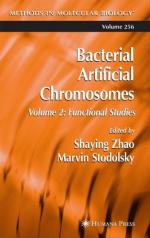|
This section contains 352 words (approx. 2 pages at 300 words per page) |
Bacterial artificial chromosomes (BACs) are large F-based plasmid vectors that can accommodate large inserts of DNA. The inserts can be up to 350,000 bases in length. Since their introduction in 1992, the BAC has served an important role in human and mammalian genomics. BACs are the most broadly used DNA cloning resource for large genome sequencing programs. They have been of fundamental importance in the Human Genome Project. Both the international public collaboration and the Celera Genomics Inc. program utilized BACs for the rapid generation of the draft of the human genome published in February 2001. The number of human BAC clones now numbers almost one million.
The BAC system is based on the well-studied Escherichia coli F factor, also called the F plasmid. Only one or two copies of the F plasmid are present per E. coli bacterium, thus reducing the potential for recombination between the large DNA fragments that can be carried by the plasmid. The large plasmid can be transferred to E. coli by the process of electroporation, where a series of controlled electrical pulses causes pores to form in the cell membranes. Plasmid DNA can then move through the pores to the cell's interior. The process is efficient, reducing the amount of DNA needed.
BACs have been very useful in the development of genome libraries. The primary reasons for their utility is that BACs cab stably maintain large DNA inserts in the bacterium E. coli, and are amenable to virtually all of the molecular biology techniques that utilize E. coli, such as colony screening and electophoresis. The vector contains sites necessary for the DNA insert to be handled and replicated like a bacterial chromosome. Large fragments of DNA from a variety of sources can be cloned into E. coli, where the DNA is stable and easy to manipulate. BACs have also proved to be useful for the physical isolation of genes, chromosome walking and fluorescence in situ hybridization.
DNA libraries other than human that have been constructed using BACs include food crops such as barley, rice and sorghum, plants such as Arabidopsis, and the mouse.
|
This section contains 352 words (approx. 2 pages at 300 words per page) |


